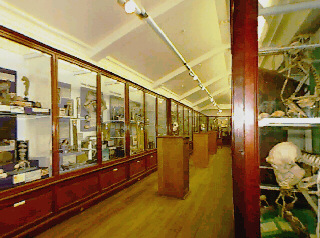
The Museum Today |
 With the changing emphasis of teaching and research in Zoology away from studies of anatomy and physiology to studies of the function of cells and molecules, it became increasingly apparent that the museum needed a re-appraisal if the specimens were to serve any educational purpose. Although the changing emphasis means that less time can be spared for detailed descriptions of animals and their structure, it is still necessary for biology students to have a sound grasp of the animal kingdom and the essential role animals play in the 'well being' of our planet. The idea arose, therefore, to re-organise the collection and to use it to demonstrate the diversity of animal life as a backcloth for physiological, cellular and molecular studies of animal biology. It also became apparent that the collection represented much important pioneering work in animal biology carried out over the last century by many very eminent scientists. These facts led to the establishment of a Community Programme Unit - supported by the Manpower Services Commission - within the Department of Zoology. The objectives of the Unit were to re-awaken interest in the Natural History Collection and its history, to ensure its continued conservation and, especially, to display the collection so that it could be visited, once again, by the public and members of the University alike. The Unit's work has included the creation of displays to show the diversity of invertebrate animals and the way they live. It was decided to concentrate initially on the invertebrate material since, in spite of their ecological and economic importance, they are still largely unfamiliar to most people as compared to the larger vertebrates. The Unit also computerized the existing invertebrate catalogue and produced this brief account of the collections and their colourful, often turbulent, history. 
During 1996 and 1997, the vertebrate specimens housed in the museum gallery were redisplayed by Zoology Honours students. Members of the Unit also wrote this short account and the 'Full History' of the Collections. In December 1997, the gallery was named in honour of Aubrey Manning, Professor of Natural History (1973-1997). The foundations of the Natural History Collections' web site were laid in 1997 with the creation of a "virtual gallery" and web pages describing some of the mammalian specimens. Since then attention has focused on expanding the web site to extend the use of the Collections to those unable to visit in person. |






